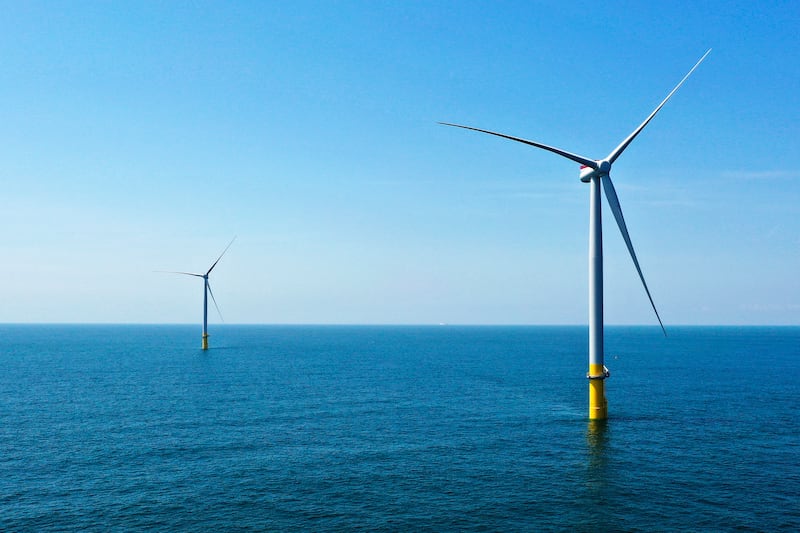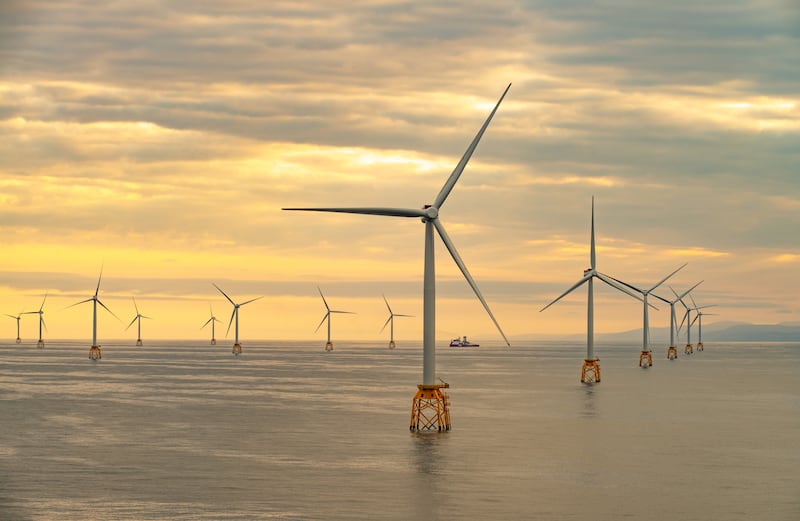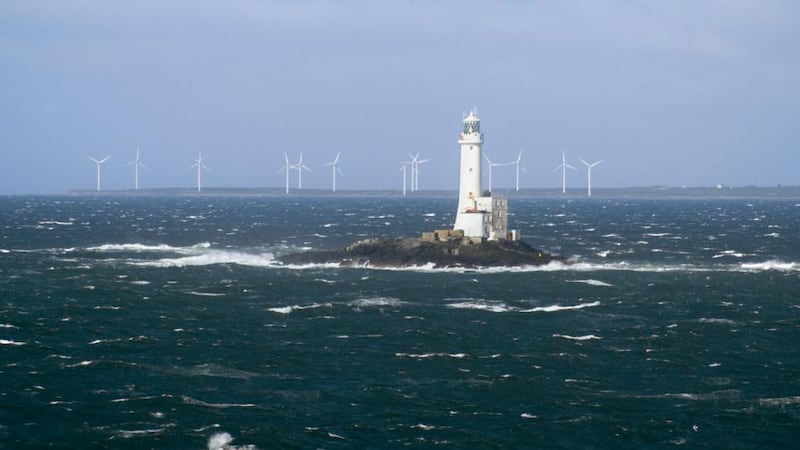Later this year, France, Norway, Portugal and the UK will auction parts of their territorial waters to develop floating offshore wind. Kevin Lynch, chief executive of renewables developer Source Galileo, says that his industry, the EU and most national governments now recognise that floating and deep-fixed wind turbines off Europe’s northwest coast is the continent’s future energy source.
“People can argue if they want to,” he says. “We’re happy to have the debate that it will be something else, but that’s what it’s going to be. And the further offshore you go the better, because the wind is better, and these are big machines, around 60m, so you don’t want to have it 5km off the coast of Brittas Bay, you want to have it 30km or 40km.”
A good floating wind farm will produce electricity for 4,500 to 5,000 hours a year, out of 8,766 hours in total, so they can function up to about 60 per cent of the time. By contrast, an Irish solar farm will generate for 900 hours while onshore wind will do so around one third of the time.
Lynch argues that one vital piece of this emerging jigsaw is missing: this country. Our territorial waters are the biggest in the EU; neither the UK nor Norway are members of the bloc, while our seas sit directly in the area that the EU recognises as key to its future energy needs.
READ MORE
A recent Government draft of its new offshore renewable policy estimates that Irish waters have the capacity for 579 gigawatts (GW) of floating wind. To put that in context, 1GW is 1,000 megawatts (MW).
Lynch points out that 100GW of floating wind, which he argues should be possible to build in Irish waters by 2050, would provide three times our energy needs, giving us scope to export electricity to a Europe desperate for renewable sources of power
National grid operator EirGrid recently reported that the Republic set a new record for electricity consumption during last month’s cold spell: 5,577MW. The State’s current offshore plans, which only cover the now established shallow-fixed offshore wind energy, call for 5GW by 2030.
Lynch points out that 100GW of floating wind, which he argues should be possible to build in Irish waters by 2050, would provide three times our energy needs, giving us scope to export electricity to a Europe desperate for renewable sources of power.

It also opens the door to producing green hydrogen, now viewed as one of the best ways of eliminating carbon emissions from industries whose energy demand electricity cannot meet.
He acknowledges that the Government’s draft policy recognises that there is an opportunity there. “It means that they have figured out that Ireland is important,” he says. But he maintains that the State still intends doing nothing about it until after 2030. “It’s like saying that this is going to be the biggest game in town, and we’re going to get to it in six years.”
Government policy sets a target of 40GW of offshore wind by 2050. On floating wind, it calls for a study of the possibility of deploying it in Irish waters, taking auctions such as the proposed French process this year into account, and exploring the feasibility of a demonstration site.
“The scale of our offshore wind potential, when coupled with hydrogen production, offers a once-in-a-century industrial development opportunity as well as a high-value export capability,” the draft states. It adds that the Republic’s “offshore energy potential makes it central to Europe’s shared energy future”.
The draft makes it clear that the Government’s immediate priorities are completing the first phase of offshore wind development here, essentially the 5GW which will be built mostly along the east coast, and continuing preparations for the next stage, off the south coast.

Lynch argues that they have “stymied themselves” by limiting all this to shallow fixed wind. “The whole European market and world market thinks that floating and deep-fixed [wind energy] is where the market is really going to be and is what makes the industry attractive.”
He says Government’s approach puts off investors, not least Source Galileo’s own, who he says are increasingly cautious about getting involved in the Republic as they believe nothing will happen here until after 2030. Instead, they are happy to switch their attention to Norway, Portugal and the UK, countries where the company is either working on projects or preparing for upcoming auctions. “Their view on Ireland is ‘unproven, scale back’.”
[ Chasing the promise of cheaper and less obtrusive wind power generationOpens in new window ]
He says this is true across the industry, where he knows of around 100 people who were redeployed from working on Irish projects last year following the publication of another Government policy document also indicating that further offshore development would have to wait until 2030.
The UK is weighing allocating sea area for 90GW, Portugal is looking at 12GW while Norway aims for 50GW by 2030. Against this background, he argues, the Republic risks simply being a follower where it should be leading the way
All the Government has to do to reverse this is to start allocating sea areas for floating wind development, he says. “So, they just have to say: ‘these are the sea areas for deep and floating and shallow wind that we’re going to allocate.’ And they can run auctions, they can do whatever they want.” Lynch’s company will build the turbines and put in the cables needed to connect them, he adds.
At this point, the UK is weighing allocating sea area for 90GW, Portugal is looking at 12GW while Norway aims for 50GW by 2030. Against this background, he argues, the Republic risks simply being a follower where in fact it should be leading the way.
Source Galileo is already working in these countries. In Norway, it is gearing up to bid in an auction for sea area close to Haugesund in the southwest of the country. It is already working on a project to electrify all the energy used on the Goliath oilfield in the Barents Sea off the northern coast.
In the UK, it is building around 2GW of batteries used to stabilise the electricity grid when it is using a lot of wind energy, and it plans to bid for areas of the Celtic Sea in British territory.
In Portugal, Source Galileo took the first step in bidding for sea area when it responded to requests for expressions of interest in the process late last year. Lynch says that the country is continuing with the proposal despite looming elections following the recent collapse of its government. His company’s representative there regularly discusses these plans with officials.
Lynch founded Source Galileo in 2020 with fellow renewables industry veterans Torben Andersen and Fintan Whelan, who worked with the late Eddie O’Connor in Airtricity and then Mainstream, and Garett Morrison, who held senior posts in Amerenco and the Renewable Energy Agency in Britain. It began as Source Energie, but changed its name when Galileo Green Energy invested in the business.

That company’s backers are Australia’s Commonwealth Superannuation Corporation and New Zealand’s Superannuation Fund, the two countries’ respective state pension funds, and Morrison & Co Growth Infrastructure Fund. Source Galileo then took on Ingka Investments, furniture chain Ikea’s owner, and Japanese utility, Kansai, as partners on individual projects.
The idea was to develop the next wave of renewable energy, primarily floating wind. The company has offices in Dublin, Norway and London, with most staff in the Irish and Norwegian bases.
Lynch himself started as a chemical engineer, qualifying from UCD and working with Penn Chemicals in Cork before moving to GE, where he worked in its plastics division. He then got an MBA from Wharton university in Pennsylvania in the US. Stints consulting with Booz Allan Hamilton and Roland Berger followed before he joined NTR, whose US ethanol business, Green Plains, he ran. From there he moved to Amarenco Solar, working with Morrison and John Mullins, focusing on projects in France.
Even while most of its work is outside the Republic, Lynch wants Source Galileo to be an Irish company. The case for investing in floating wind here is a simple one: “They’re not doing it now but they’re going to have to do it.”
The reason, he argues, is that not doing it means missing our legally binding climate targets that are meant to drive policy in the first place. Those targets include producing 42.5 per cent of the State’s final energy consumption from renewables by 2030. He calculates that our final energy is 160 terawatt hours (TW/h), so 42.5 per cent of that is 68TW/h.
All this is going to need finance. Every gigawatt of floating offshore wind costs around €2.5 billion to build, so that 100GW we should be targeting by 2050 will have a €250 billion price tag
Electricity represents 25TW/h of the total, 9TW/h of which comes from renewables, while biofuels make up another 3.5TW/h. “So, 12.5TW/h, and we need to get to 68TW/h by 2030. How are we going to get from here to there in seven years’ time?” he asks. Not surprisingly, Lynch argues that floating wind is the answer.
On that basis, Government needs to do two things: take the steps needed to ensure the Republic meets its climate targets and recognise the opportunities that this offers. They do not only include building the offshore power plants and selling the energy produced, in whatever form.
All this is going to need finance. Every gigawatt of floating offshore wind costs around €2.5 billion to build, so that 100GW we should be targeting by 2050 will have a €250 billion price tag.
The EU has already established a green hydrogen bank to provide the hundreds of billions of euros needed to develop this fuel.
It should do the same for floating wind, whose ultimate development Lynch says cannot rely on “armies of pensioners”. That bank should be based here “in Dublin, Cork or Galway”.
For its part, he says the Government needs a latter-day TK Whitaker (the civil servant credited with laying the foundations for the Republic’s policy of luring multinational investors) to get on top of the various challenges and opportunities that the shift to renewables presents.
If he and Source Galileo are wrong, and there is a good reason for the Republic to position itself as a follower rather than a leader, then Lynch says the Government should say it “and we’ll step out of Ireland with the investors, but otherwise, what we want to do is to build this as an Irish company”.
The Department of Environment, Climate and Communications responded that the State supported the development of floating wind as emerging technology while deploying fixed technology, so that when floating technology matured and was ready to deploy, there would be no delay on the State side.
CV
Name: Kevin Lynch.
Post: Chief executive of renewables developer Source Galileo.
Why is he in the news? The company, backed by overseas investors, wants to build floating offshore wind farms in western Europe, and particularly in Irish waters.
Family: Married with children.
Something that will not surprise: He’s an engineer with an MBA.
Something that might surprise: He’s interested in history.




















